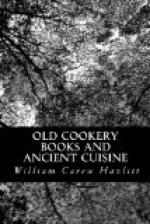In the “Leisure Hour” for 1884 was printed a series of papers on “English Homes in the Olden Times.” The eleventh deals with service and wages, and is noticed here because it affords a recital of the orders made for his household by John Harington the elder in 1566, and renewed by John Harington the younger, his son and High Sheriff of Somersetshire, in 1592.
This code of domestic discipline for an Elizabethan establishment comprises the observance of decorum and duty at table, and is at least as valuable and curious as those metrical canons and precepts which form the volume (Babees’ Book) edited for the Early English Text Society, etc.
There is rather too general a dislike on the part of antiquaries to take cognisance of matter inserted in popular periodicals upon subjects of an archaeological character; but of course the loose and flimsy treatment which this class of topics as a rule receives in the light literature of the day makes it perilous to use information so forthcoming in evidence or quotation. Articles must be rendered palatable to the general reader, and thus become worthless for all readers alike.
Most of the early descriptions and handbooks of instruction turn, naturally enough, on the demands and enjoyments of the great. There is in the treatise of Walter de Bibblesworth (14th century) a very interesting and edifying account of the arrangement of courses for some important banquet. The boar’s head holds the place of honour in the list, and venison follows, and various dishes of roast. Among the birds to be served up we see cranes, peacocks, swans, and wild geese; and of the smaller varieties, fieldfares, plovers, and larks. There were wines; but the writer only particularises them as white and red. The haunch of venison was then an ordinary dish, as well as kid. They seem to have sometimes roasted and sometimes boiled them. Not only the pheasant and partridge appear, but the quail,—which is at present scarcer in this country, though so plentiful abroad,—the duck, and the mallard.
In connection with venison, it is worth while to draw attention to a passage in the “Privy Purse Expenses of Henry VII” where, under date of August 8, 1505, a woman receives 3s. d. for clarifying deer suet for the King. This was not for culinary but for medicinal purposes, as it was then, and much later, employed as an ointment.
Both William I. and his son the Red King maintained, as Warner shews us, a splendid table; and we have particulars of the princely scale on which an Abbot of Canterbury celebrated his installation in 1309. The archbishops of those times, if they exercised inordinate authority, at any rate dispensed in a magnificent manner among the poor and infirm a large portion of their revenues. They stood in the place of corporations and Poor Law Guardians. Their very vices were not without a certain fascinating grandeur; and the pleasures of the table in which our Plantagenet rulers outstripped even their precursors, the earlier sovereigns of that line, were enhanced and multiplied by the Crusades, by the commencing spirit of discovery, and by the foreign intermarriages, which became so frequent.




